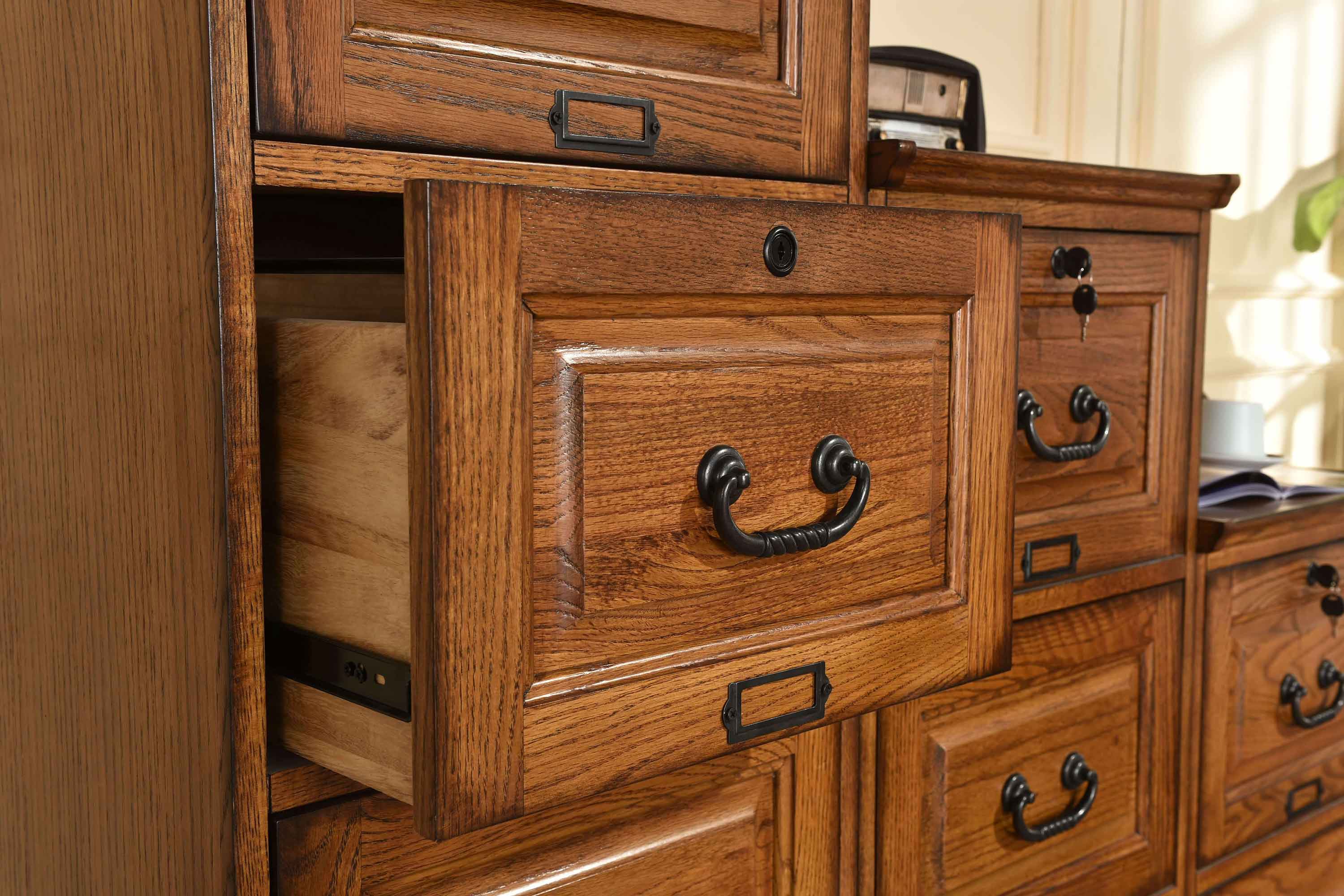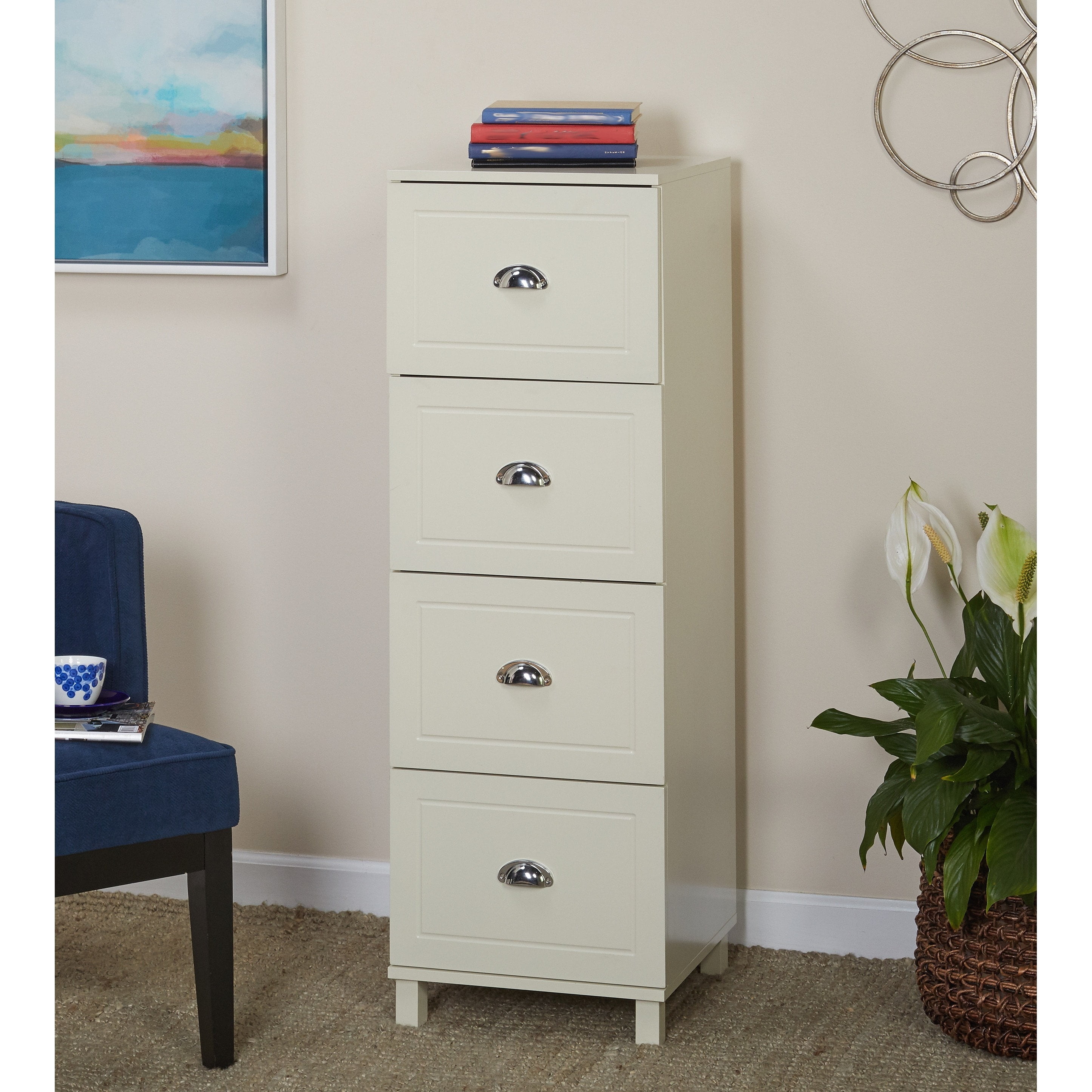The Essential Guide to 4-Drawer Wood File Cabinets

A 4-drawer wood file cabinet is an essential piece of furniture for any home or office that needs to store and organize important documents, files, and other paperwork. These cabinets offer a durable and stylish way to keep your paperwork safe and accessible.
Benefits of 4-Drawer Wood File Cabinets
4-drawer wood file cabinets offer numerous benefits that make them a popular choice for both residential and commercial settings.
- Durable Construction: Made from sturdy wood, these cabinets are built to last and withstand heavy use. They can handle the weight of numerous files and folders without bending or warping.
- Ample Storage: With four spacious drawers, these cabinets provide ample storage space for a large volume of documents. This helps to keep your workspace organized and clutter-free.
- Easy Accessibility: The drawers slide smoothly and effortlessly, allowing for quick and easy access to your files. This makes it convenient to retrieve and file documents without hassle.
- Versatile Design: 4-drawer wood file cabinets are available in various styles and finishes to complement any decor. You can choose from traditional, modern, or contemporary designs to match your existing furniture.
- Improved Organization: These cabinets help you organize your files efficiently. They provide a dedicated space for each category of documents, making it easy to find what you need quickly.
- Protection from Damage: Wood file cabinets offer protection against dust, moisture, and other environmental factors that can damage your important documents.
Choosing the Right 4-Drawer Wood File Cabinet
Selecting the right 4-drawer wood file cabinet for your needs involves considering several key factors:
- Size: The size of the cabinet is crucial to ensure it fits comfortably in your space and accommodates your storage needs. Measure the available area and consider the height, width, and depth of the cabinet.
- Material: While wood is the most common material, you can also find cabinets made from metal or a combination of both. Consider the durability, style, and maintenance requirements of each material.
- Style: The style of the cabinet should complement your existing decor. Choose from traditional, modern, or contemporary designs to match your taste and aesthetic preferences.
- Functionality: Consider features like drawer glides, locking mechanisms, and additional storage options. These features can enhance the usability and security of your cabinet.
Organizing Your 4-Drawer Wood File Cabinet
Maximizing storage space and keeping your 4-drawer wood file cabinet organized is essential for efficient document management.
- File Folders: Use file folders to categorize and organize your documents. Label them clearly and consistently for easy identification.
- Hanging Files: Consider using hanging file folders for greater organization and accessibility. These folders hang on rails within the drawers, allowing for easy access to individual files.
- Dividers: Utilize dividers to separate different categories of documents within each drawer. This helps to create a more structured filing system and makes it easier to locate specific files.
- Labels: Label each drawer with a clear and concise description of its contents. This allows for quick identification of the drawer you need to access.
- Vertical Storage: Use vertical storage solutions like file trays or magazine holders to maximize space and organize items that don’t fit in standard folders.
Types of 4-Drawer Wood File Cabinets, 4 drawer wood file cabinet
4-drawer wood file cabinets come in various types to cater to different needs and preferences.
- Lateral File Cabinets: These cabinets are typically wider than they are tall, providing ample drawer space for lateral filing. They are ideal for storing large volumes of documents and are often used in offices.
- Vertical File Cabinets: These cabinets are taller than they are wide, making them suitable for smaller spaces. They are often used in homes or small offices where space is limited.
- Mobile File Cabinets: These cabinets have wheels, making them easy to move around. They are ideal for situations where you need to access files from multiple locations.
Tips for Maintaining Your 4-Drawer Wood File Cabinet
Regular maintenance helps to ensure the longevity and functionality of your 4-drawer wood file cabinet.
- Dust Regularly: Dust the cabinet regularly with a soft cloth to prevent the accumulation of dust and debris.
- Clean Spills Immediately: If any spills occur, clean them up immediately to prevent damage to the wood. Use a damp cloth and mild detergent to clean the cabinet.
- Lubricate Drawer Glides: Periodically lubricate the drawer glides with silicone spray to ensure smooth operation.
Types of 4-Drawer Wood File Cabinets: 4 Drawer Wood File Cabinet

4-drawer wood file cabinets come in a variety of styles and designs to suit different needs and preferences. Understanding the different types and their features can help you choose the best option for your specific requirements.
Lateral File Cabinets
Lateral file cabinets are the most common type of file cabinet. They feature drawers that slide out horizontally, making it easy to access files. These cabinets are typically made from solid wood, with a durable finish that can withstand years of use. Lateral file cabinets are available in a range of sizes, from small, compact units to larger, multi-drawer cabinets that can hold a significant amount of files.
Advantages of Lateral File Cabinets:
- Durability: Solid wood construction ensures longevity and resistance to wear and tear.
- Accessibility: Horizontal drawers provide easy access to files.
- Versatility: Available in various sizes to accommodate different storage needs.
- Aesthetics: Wood finishes can enhance the overall look of your office.
Disadvantages of Lateral File Cabinets:
- Space Requirements: Can take up more floor space compared to vertical file cabinets.
- Weight: Solid wood construction can make them heavy, making them difficult to move.
- Cost: Can be more expensive than other types of file cabinets.
Examples of Lateral File Cabinets:
- Hon 4-Drawer Lateral File Cabinet: Known for its sturdy construction and sleek design.
- Sauder 4-Drawer Lateral File Cabinet: Offers a more affordable option with a variety of wood finishes.
- Bush Business Furniture 4-Drawer Lateral File Cabinet: Features a spacious design and ample storage capacity.
Vertical File Cabinets
Vertical file cabinets are designed with drawers that slide out vertically. This type of cabinet is ideal for smaller spaces, as it takes up less floor space than a lateral file cabinet. Vertical file cabinets are typically made from wood or metal, and they often feature a locking mechanism for security.
Advantages of Vertical File Cabinets:
- Space-Saving: Takes up less floor space compared to lateral file cabinets.
- Accessibility: Vertical drawers provide easy access to files.
- Security: Often feature locking mechanisms for secure storage.
Disadvantages of Vertical File Cabinets:
- Limited Storage Capacity: Can hold fewer files than lateral file cabinets.
- Less Durable: Wood or metal construction may not be as durable as solid wood lateral file cabinets.
Examples of Vertical File Cabinets:
- Stackable Vertical File Cabinets: These cabinets can be stacked to create a customized storage solution.
- Mobile Vertical File Cabinets: These cabinets are mounted on wheels for easy mobility.
Fireproof File Cabinets
Fireproof file cabinets are designed to protect important documents from fire damage. These cabinets are constructed with fire-resistant materials and feature a special seal that prevents heat and smoke from entering. Fireproof file cabinets are typically more expensive than standard file cabinets, but they offer peace of mind knowing that your valuable documents are protected.
Advantages of Fireproof File Cabinets:
- Fire Protection: Protects important documents from fire damage.
- Security: Often feature locking mechanisms for added security.
Disadvantages of Fireproof File Cabinets:
- High Cost: More expensive than standard file cabinets.
- Weight: Fireproof materials make these cabinets heavier.
Examples of Fireproof File Cabinets:
- Sentry Fireproof File Cabinet: Offers a high level of fire protection with a 1-hour fire rating.
- Chubb Fireproof File Cabinet: Features a durable construction and a secure locking mechanism.
Choosing the Right 4-Drawer Wood File Cabinet

Selecting the perfect 4-drawer wood file cabinet involves considering various factors to ensure it meets your specific needs and preferences. It’s not just about finding a cabinet that looks good; it’s about finding one that’s functional, durable, and fits seamlessly into your workspace.
Budget
Setting a budget before you start shopping is crucial. 4-drawer wood file cabinets come in a wide range of prices, depending on the materials used, the quality of construction, and additional features. Knowing your budget will help you narrow down your choices and avoid overspending.
Space Constraints
Measure the space where you plan to place the cabinet. This includes the width, depth, and height. Consider any obstacles like doorways, furniture, or electrical outlets.
- Width: Ensure the cabinet fits comfortably in your chosen location, leaving enough space for easy access to drawers and for you to move around freely.
- Depth: Ensure the cabinet depth doesn’t impede movement in the room. If you have limited space, consider a shallower cabinet.
- Height: The cabinet’s height should be suitable for comfortable use. If you’re tall, a taller cabinet might be more convenient, while a shorter cabinet might be better for those with limited reach.
Storage Needs
Determine the amount of storage space you need. Consider the type of files you’ll be storing, their size, and how frequently you access them.
- File Size: Standard letter-sized files are the most common, but you might need a cabinet with larger drawers for legal-sized files.
- File Quantity: Estimate the number of files you’ll need to store. If you have a large volume of files, you might consider a cabinet with additional drawers or a larger capacity per drawer.
- Frequency of Access: If you frequently access files, choose a cabinet with easy-to-open drawers and smooth-gliding slides.
Personal Preferences
Personal preferences play a significant role in choosing the right cabinet.
- Style: Choose a style that complements your office decor. Consider the color, finish, and design elements.
- Features: Decide on the features that are important to you, such as lockable drawers, built-in organizers, or adjustable shelves.
- Materials: Wood file cabinets are available in various wood types, each with its own characteristics. Consider the durability, appearance, and price of different wood options.
Essential Features
- Durable Construction: Look for a cabinet made from high-quality materials with sturdy construction. This ensures it can withstand regular use and hold heavy files without warping or breaking.
- Smooth-gliding Drawers: Ensure the drawers open and close smoothly and effortlessly. This makes it easy to access files and prevents damage to the cabinet.
- Easy-to-clean Finish: Choose a cabinet with a finish that’s easy to clean and maintain. This helps keep your workspace looking neat and organized.
- Optional Features: Consider features like lockable drawers, built-in organizers, or adjustable shelves, depending on your specific needs.
